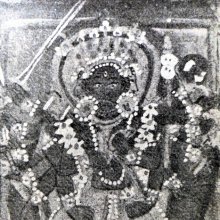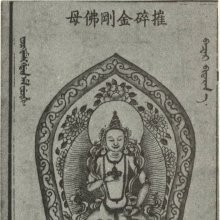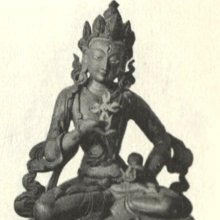Vajravidarani, Vajravidāraṇī, Vajra-vidarani: 1 definition
Introduction:
Vajravidarani means something in Buddhism, Pali. If you want to know the exact meaning, history, etymology or English translation of this term then check out the descriptions on this page. Add your comment or reference to a book if you want to contribute to this summary article.
Images (photo gallery)
In Buddhism
Tibetan Buddhism (Vajrayana or tantric Buddhism)
Source: archive.org: The Indian Buddhist IconographyVajravidāraṇī (वज्रविदारणी) refers to one of the female emanations of Akṣobhya, as mentioned in the 12th century Dharmakośasaṃgraha (a work dealing with iconography of Buddhist deities) written by Amṛtānanda.
Vajravidāraṇī is described in the Dharmakośasaṃgraha as follows:
“Vajravidāraṇī is five-faced, ten-armed, carries in the right hands the goad, the sword, the arrow, the vajra, and the varada-mudrā, and in the left the noose, the shield, the bow, the flag and the abhaya pose. She stands in the pratyālīḍha attitude.”

Tibetan Buddhism includes schools such as Nyingma, Kadampa, Kagyu and Gelug. Their primary canon of literature is divided in two broad categories: The Kangyur, which consists of Buddha’s words, and the Tengyur, which includes commentaries from various sources. Esotericism and tantra techniques (vajrayāna) are collected indepently.
See also (Relevant definitions)
Relevant text
Search found 1 books and stories containing Vajravidarani, Vajravidāraṇī, Vajra-vidarani, Vajra-vidāraṇī; (plurals include: Vajravidaranis, Vajravidāraṇīs, vidaranis, vidāraṇīs). You can also click to the full overview containing English textual excerpts. Below are direct links for the most relevant articles:
The Indian Buddhist Iconography (by Benoytosh Bhattachacharyya)
Related products


